|
Below you will find an archive of SmartRisk Report Newsletter. Browse through the issues below, or follow the link located at the bottom of this page to subscribe to our newsletter.
|
 | Is That a Go or No/Go? (Feb 2024)
Approximately 70% of claims filed against design firms comes from the person who hired you, the project owner. Just because a client wants to hire your firm - doesn’t mean that’s the right client for you. Sometimes the best decision you can make is walking away from a bad client. Great care is needed when selecting clients and projects – and in return will dramatically reduce the chance of working on a problematic, unprofitable project that routinely leads to litigation.
|
 | Don't Swallow The Poison Pill (Feb 2024)
Don't Swallow The Poison Pill
What do you do when you’re given an ultimatum, take-it-or-leave-it in a contract negotiation? If you’re been negotiating contracts, you’ve faced this situation at some point with a difficult client or attorney representing them. |
 | A/E Pro5 Risk Assessment Results (May 2023)
A/E Pro5 Risk Assessment Results
Design and construction projects are risky, and claims increase during changing economic conditions. Approximately 20 percent of design firms will have a claim each year. They are distracting, costly including efforts by senior management handling the claim, time away from current projects, negative impact on the firms reputation and business opportunities. There are legal costs and increase to insurance premiums. Approximately 75 percent of litigation are caused by ineffective operational and business practices. The higher risk operational categories, top causes of claims and example of recommendations are identified in this article. |
 | Growth, Challenges & Social Inflation (Oct 2022)
Growth, Challenges & Social Inflation
Report October 2022
SmartRisk
- Firm specifc analysis, solutions
- Reduce risk and liability exposures
- Improve performance and profitablity
Clients - 95% excellent rating, recommend to other firms.
Please contact u |
 | Buying or Selling Your Firm - Risk Considerations (Aug 2022)
Buying or Selling Your Firm - Risk Considerations
Report August 2022
SmartRisk
Focus on improving performance and profitablity through firm specific analysis and solutions.
Over 90% of our revenue comes from repeat, highly satisfied clients.
Please contact us to discuss our services. &n |
 | Construction, GDP and Risk (Aug 2022)
Construction Trends, GDP & Risk
Report August 2022
SmartRisk
SmartRisk is a risk and performance management consultancy focusing on improving overall performance and profitablity through firm specific risk management solutions.
If you have any questions, or would like to dicuss our service offerings, please contact us. Thank you. &n |
 | Wrong Client - Problems Ahead (Sep 2022)
Wrong Client - Problems Ahead
Report September 2022
SmartRisk
- Firm specifc analysis, solutions
- Reduce risk and liability exposures
- Improve performance and profitablity
Clients - 95% excellent rating, recommend to other firms.
Please contact us to di |
 | #1 Cause of Claims - Communication (Oct 2022)
#1 Cause of Claims - Communication
Report October 2022
SmartRisk
- Firm specifc analysis & solutions
- Reduction of risk and liability exposures
- Improvements in performance and profitability
- Lowering insurance costs
http://smartrisk.biz/ Clients & Test |
 | #1 Priority for Design Firms - Profitability (Feb 2022)
Design Firms #1 Priority - Profitability
REPORT
Risk Performance Strategies February 2022 www.smartrisk.biz
Mailing List Link:
Join Our Newsletter Link View Past Newsletters: Archive Newsletters Link
What is Your Firms Risk Profile? Risk Indication Link
Quick Links Section
Insurance, Risk or Professional Liability (PL) Question? Ask SmartRisk
#1 Priority for Design Firms – Profitabilit |
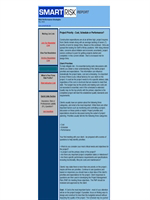 | Client Priority - Cost, Schedule or Performance? (May 2022)
Client Priority - Cost, Schedule or Performance
REPORT
Risk Performance Strategies May 2022 www.smartrisk.biz
Mailing List Link:
Join Our Newsletter Link View Past Newsletters: Archive Newsletters Link
What is Your Firms Risk Profile? Risk Indication Link
Quick Links Section
Insurance, Risk or Professional Liability (PL) Question? Ask SmartRisk
Project Priority - Cost, Schedule or Perfor |
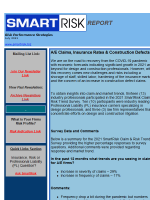 | A/E Claims, Insurance Rates & Construction Defects (Jul 2021)
We are on the road to recovery from the COVID-19 pandemic with economic forecasts indicating significiant growth in 2021 and beyond for design and construction professionals. However, with this recovery comes new challenges and risks including a shorage of staff, skilled labor, hardening of the insurance market, and the concern of an increase in construction defect claims. Here are results from a SmartRisk Survey of insurance carriers and law firms. |
 | Construction Spending Improves and Risks (May 2021)
REPORT
Risk Performance Strategies May 2021 www.smartrisk.biz
Mailing List Link:
Join Our Newsletter Link View Past Newsletters: Archive Newsletters Link
What is Your Firms Risk Profile? Free Risk Assessment Risk Indication Link
Quick Links Section
Insurance, Risk or Professional Liability (PL) Question? Ask SmartRisk
Construction Spending Improves and Risks Driven by COVID-19 pandemic, chaos was brought to t |
 | COVID-19 Reopening, Growth Trends & Risks (Jun 2021)
REPORT
Risk Performance Strategies June 2021 www.smartrisk.biz
Mailing List Link:
Join Our Newsletter Link View Past Newsletters: Archive Newsletters Link
What is Your Firms Risk Profile? Risk Indication Link
Quick Links Section
Insurance, Risk or Professional Liability (PL) Question? Ask SmartRisk
COVID-19 Reopening, Growth Trends & Risks Construction Expenditures Except for the 2020 interruption driven by C |
 | Improve Performance and Profitability (Feb 2021)
The pandemic has impacted many design firms.
One common objective for a majority of firms, improving performance and profitability.
There are common characteristics of the higher performers and profitable design firms. These firms have incorporated a more enterprise-wide approach to risk management.
|
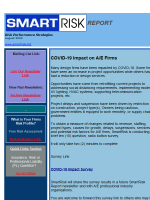 | COVID-19 Impact on A/E Firms (Aug 2020)
REPORT
Risk Performance Strategies August 2020 www.smartrisk.biz
Mailing List Link:
Join Our Newsletter Link View Past Newsletters: Archive Newsletters Link
What is Your Firms Risk Profile? Free Risk Assessment Risk Indication Link
Quick Links Section
Insurance, Risk or Professional Liability (PL) Question? Ask SmartRisk
COVID-19 Impact on A/E Firms
Many design firms have been impacted by COVID-19. Some firms |
 | Pandemics Driving Design Changes (Jun 2020)
The 21st Century has so far seen Sars, Mers, Ebola, bird flu, swine flu and now Covid-19. We have entered an era of pandemics. Lets identify how pandemics have changed design features in the past and present.
|
 | Benefits of a Catastrofic Event (May 2020)
REPORT
Risk Performance Strategies May 2020 www.smartrisk.biz
Mailing List Link:
Join Our Newsletter Link View Past Newsletters: Archive Newsletters Link
What is Your Firms Risk Profile? Free Risk Assessment Risk Indication Link
Quick Links Section
Insurance, Risk or Professional Liability (PL) Question? Ask SmartRisk
Benefits Of A Catastrophic Event There are benefits that can be obtained when handling cata |
 | COVID-19 Construction Shutdown, Workforce, Contract Risk (Apr 2020)
COVID-19
Construction Shutdown Warning
Essential Workforce
Contract Risk
There has been significant developments in the last two weeks within the design and construction industry driven by the pandematic. Some of you may have seen some, or all of the SmartRisk newletter articles recently written addressing important topics regarding the COVID-19 crisis and its impact.
For your convenience I have included links to the three articles in this newsletter. |
 | COVID-19 Construction Site Shutdown Warning (Apr 2020)
Construction sites are coming under a high degree of scrutiny with compliance with COVID-19 program requirements. Los Angeles Mayor Eric Garcetti issued new COVID-19 safety guidance for construction sites after reports that some construction sites were not complying with the city’s safer-at-home order.
On March 31, 2020, L. A. Building and Safety issued Announcement No.5 related to guidelines for Construction industry employers. Not compliance could lead to shutting down the construction site. |
 | Essential Critical Workforce Guidance (Mar 2020)
There has been confusion at the federal, State and local levels as to what operations, businesses and services that could continue during the COVIC-19 crisis based on being identified as “essential and critical” for our country. Efforts by design and construction organizations, including the U.S. Chamber of Commerce have urged the administration to issue guidance and exemptions clarifying sectors and services that could continue during the crisis.
On Saturday March 28, 2020 the Department of Homeland Security (DHS) and the Cybersecurity and Infrastructure Agency (CISA) released version 2.0 of their " Guidance on the Essential Critical Infrastructure Workforce".
The document has been developed with federal agencies, State and local governments, and the private sector. The purpose is to identify the essential and critical infrastructure sectors vital to the stability of functions critical to public health, safety and economic and national security of our country.
|
 | |
 | Coronavirus Pandemic - Need More Toilet Paper! (Mar 2020)
From Disneyland to the U.S. Supreme Court, from Wall Street to Dodgers Stadium, nearly every facet of American life fell into turmoil with the coronavirus outbreak causing sweeping closures and economic disruption. Restaurants in major cities and regions including McDonalds and Starbucks has moved to a "take out and delivery" models to facilitate social distancing among customers. |
 | Subcontractor $22 Million Dollar Claim Caused by Design Errors (Nov 2019)
REPORT
Risk Performance Strategies November 2019 www.smartrisk.biz
Mailing List Link:
Join Our Newsletter Link View Past Newsletters: Archive Newsletters Link
What is Your Firms Risk Profile? Free Risk Assessment Risk Indication Link
Quick Links Section
Insurance, Risk or Professional Liability (PL) Question? Ask SmartRisk
Subcontractor $22 Million Dollar Claim Caused by Design Errors |
 | Armed With Information - Claim Survey Results (Aug 2019)
REPORT
Risk Performance Strategies August 2019 www.smartrisk.biz
Mailing List Link:
Join Our Newsletter Link View Past Newsletters: Archive Newsletters Link
What is Your Firms Risk Profile? Free Risk Assessment Risk Indication Link
Quick Links Section
Insurance, Risk or Professional Liability (PL) Question? Ask SmartRisk
Armed With Information – Claim Survey Results
Many design fir |
 | A/E's Buying or Selling - Helpful Tool (Jul 2019)
There are many reasons and drivers for mergers and acquisitions (M&A) activity for architect and engineering firms. With rather strong economic conditions, transactions are being driven by a desire for service diversification and merging or acquiring another firm to become a more “full service” provider offering a full array of services. Another reason, duirng strong economic conditions, it is a great time to obtain top dollar for your firm. |
 | Prime Causes of Liability Claims (May 2019)
Architect and Engineers (A/E) can be found liable for damages in various situations, depending on who claims damage, and the basis of the claim. For example, where an owner has a direct contract with the A/E firm, the owner could bring a claim based on the contract or a claim based in a tort action. Such action, based in negligence, is a claim for malpractice against the design firm. Below are four prime causes of liability claims against A/E firms. |
 | Top 10 Reasons Why Projects Fail (Mar 2019)
This newsletter identifies the top 10 reason why projects fail that includes, project expectations, official approval, staffing, handling of conflicts, team approach, managing project scope and others. |
 | Reasons to Avoid Binding Arbitration (Nov 2018)
Binding arbitration - a formal dispute resolution technique in which the opposing parties present their cases before one or more neutral individuals who are empowered to render a binding and court-enforceable decision. Although this process was originally intended to offer significant benefits over litigation by providing a forum in which disputes could be resolved without the spending of large amounts of time and money, this has proven not to be the case. It has shown to be an unsatisfactory, and sometimes disastrous remedy. |
 | Risky Contract Agreements (Aug 2018)
The contract agreement outlines the responsibilities of the parties and the terms and conditions when rendering services for a project. The contract determines the obligations, and if there is a claim, aids in the defense of a design professional.When developing your next contract agreement, here are some items to consider...... |
 | Hiring Challenges Continues - With A New Twist (Jun 2018)
Having experienced and proper staffing levels is critical for the success of any firm and project. However, in a recent industry survey of design firms, 87% are having trouble filling positions within their organization. However, the process for evaluating prospects is not addressing all concerns. |
 | NEW Risk Management Chapter - CSI Project Delivery Practice Guide (Jan 2018)
The Construction Specifications Institute (CSI) has recently published CSI’s Project Delivery Practice Guide (PDPG) 2nd Edition. In this new edition, content has been included that aligns with current industry practices, plus the addition of the important topic of risk management in the design and construction process. SmartRisk's supported CSI as the author of the new Risk Management Chapter.
|
 | Industry Forecast, Claims and Risk (Dec 2017)
With 2017 coming to an end, lets take a brief look at this year, and what is expected for 2018.
Construction spending and projects are expected to remain strong in 2018 with a forecast of a 4.8% increase. Residential construction, especially single-family construction, is expected to remain strong. Lodging construction, including hotels and motels, is expected to be down after experiencing growth in 2017. Public construction has declined in 2017, but expects growth with airport construction expansion in terminals and runways, as well as public education construction spending. A big question remains for highway construction as federal spending remains flat, however states are continuing to pursue increases in gas taxes and public-private partnerships (P3s) to fund road and infrastructure projects. Retail construction is expected to continue its decline in 2018 driven by e-commerce. |
 | Key Contract Provisions (Nov 2017)
The contract outlines the roles and responsibilities of the parties. Contracts are also used in determining the obligations and defenses a design professional may have when a claim has been filed. It is important to develop standard terms and conditions for your firm, and attach them to every proposal.
|
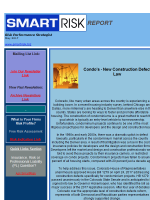 | Condo's - New Construction Defect Law (May 2017)
Colorado, like many urban areas across the country is experiencing a building boom. In a recent housing industry survey, behind Chicago and Dallas, more millennia’s are heading to Denver than anywhere else in the country. States are looking for ways to foster and promote affordable housing. The construction of condominiums is a great method to reach that goal which is typically an entry-level vehicle to homeownership. Unfortunately, condominium projects continue to be one of the most litigious project types for developers and the design and construction team. |
 | 49% of Businesses Victim of Cyber Attacks (Feb 2017)
Nearly half of businesses report that they were the subject of a cyber-ransom campaign in 2016, according to Radware's Global Application and Network Security Report 2016-2017. Technology may be one aspect of cyber security, but the real challenge is managing the human element of an organization. |
 | Cyber Risk - Trends and Critical Infrastructure (Oct 2016)
The U.S. federal government, banks, and businesses are spending big bucks in a war against hackers and cyber criminals. Cybersecurity budgets are rising in all industries alongside the cyber crime figures. Consider some of the latest market summary and forecast data:
British insurance company Lloyd’s estimated that cyber attacks cost businesses as much as $400 billion a year currently, and growing, which includes direct damage plus post-attack disruption to the normal course of business. |
 | Pre-Mortem Risk Management Part 2 (Aug 2016)
In Part 1 we discussed how unidentified and mismanaged risk for any project can be deadly and very costly for any firm. It is recommended what I call a pre-mortem risk management process when considering a project. This includes upfront identification of what potentially could go wrong, and implementing risk management measures for avoiding such threats. Once risks have been identified and assessed, techniques and strategies to manage risk fall into one of four categories:
1. Risk Avoidance
2. Risk Reduction
3. Risk Sharing and Transfer
4. Risk Retention
|
 | Pre-Mortem Risk Management (Jun 2016)
When someone has died and a determination of the cause and manner of death is needed, a post-mortem examination is performed. Unidentified and mismanaged risk for any project can be deadly and very costly for any firm. I recommend applying what I call a pre-mortem risk management process when considering a project. This includes upfront identification of what potentially could go wrong, and implementing risk management measures for avoiding such threats. Tackling this process effectively could mean the difference between a successful, profitable project or one that a leads to losses, claims and litigation.
|
 | Saying No To Clients (Apr 2016)
Saying NO to Client’s is very difficult for many architect, engineer and environmental consulting (A/E/E) firms. A/E/E's are creative thinkers, problem solvers, paid to create solutions for Clients. Saying no goes against the very fiber that drew them to the profession. However, there are situations when saying no is the best course of action. |
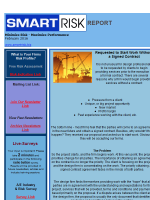 | Starting Work Without a Signed Contract (Feb 2016)
It is not unusual for design professionals to be requested by clients to begin providing services prior to the execution of a formal contract. There are several reasons why a firm would consider beginning services without a contract; Pressure from a client,
Unique or big project opportunity, New market,
Profit margin, Past experience working with the client, etc. |
 | Insurance - A Safety Net When Things Go Wrong (Mar 2016)
Professional liability (PL) insurance, also called Errors and Omissions (E&O) plays an important role supporting design firms risk management program. It is essential that risk management strategies are implemented into the culture and operational practices of a firm - and when there is a problem, insurance is a safety net to help mitigate the risk. |
 | Contracts - You Get What You Negotiate (Aug 2015)
In preparing a contract, you need to be specific, and absolutely clear about what you want, will agree to, and the responsibilities of the parties. When negotiating, the objective is to obtain an outcome where all parties feel that a fair and balanced agreement has been reached. If one party feels like they have been treated unfairly, forced into accepting a contract, or provision, this could impact the relationship, as well decisions that could influence services and performance on the project. For example, if a firm feels their fee has been reduced to unacceptable levels to be profitable, they may use less experienced, and costly staff on the project. This would impact the overall quality of services, performance and client satisfaction. |
 | How Effective is Your Risk Management Program? (Jul 2015)
Many design firms attend risk management training sessions and implement certain practices based on an industry trend or claim. Other firms may only concentrate on contracts and insurance coverage’s as a risk management strategy, which is only a portion of an effective risk management program. As they say – “you cannot manage a program that is not measured.” So, the first question that should be asked - How effective is your risk management program? An excellent method in answering that question is determining your firm’s risk profile. Every design firm has a different risk profile based on their unique characteristics - background, staffing, experience, services, applied processes, practices, claim activity, project types, clients, geographic region and other features. |
 | Apartment Trends - Condo Caution (Jul 2015)
Multifamily apartment projects have been volatile month-to-month for the last five months. Based on the Architectural Billing Index (ABI) for the multifamily sector, it may be slowing, however multifamily project permits were high last month - so we might see another pickup in apartment project starts.
We have had quite a boom in apartments projects since 2012. The drivers were 1) very low supply, and 2) strong demand with people moving from owning to renting based on more restrictive lending practices by banks. In 2011, the national rental vacancy rate was 8%. Today, the vacancy rate is holding at 4.2%, the lowest level since the end of 2001. This is only the third quarter in three decades that the rental vacancy rate has fallen below 5% causing values for apartment projects to rise. |
 | Claim Scenarios for Design Firms (May 2015)
Not all claims against architects and engineers (A/E) firms for errors and omissions can be anticipated. However, awareness and looking for a few common warning signs will help mitigate project risk. When and how you respond in these situations will greatly assist in minimizing risk, and the possibility of a claim for the firm. |
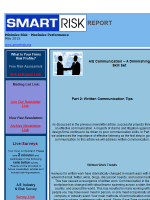 | A/E Communication – Part 2 (May 2015)
As discussed in the previous newsletter article, successful projects thrive on effective communication. A majority of claims and litigation against design firms continue to be driven by poor communication skills. In Part 1, we addressed the importance of effective listening as the first step in good communication. In this article we will address written communication. |
 | A/E Communication – A Diminishing Skill Set (Feb 2015)
Successful projects thrive on effective communication. The primary purpose of any service-oriented company, including design firms is to provide meaningful information and services to your clients. Effective communication is a key in reaching that objective. However, based on claims data, most claims against design firms are driven by poor communication skills. This trend is becoming dramatically worst with younger design professionals becoming more reliant communicating with smart phones and computers than through personal contact, further eroding communication capabilities. Failed communication negatively impacts the ability of understanding a clients needs and expectations, resulting in unsatisfied customers. This leads to lost revenue and business opportunities for your firm and the increased potential for claims and litigation. |
 | A/E Insurance Update & Carrier Selection (Jan 2015)
We have more insurance carriers, between 50 – 60 insurance providers supporting this specialized insurance market compared to approximately 15 in 2007. The increase of carriers has advantages for A/E firms – more options with an enormous amount of insurance capacity (amount of available insurance). The disadvantages - selecting a carrier has become more difficult with wide variations and low cost providers looking very attractive.
|
 | Claims, Insurance Options and Risk Profile (Jul 2014)
The design and construction industry can be very litigious for design firms. As an insurance agent specializing in design professionals, I have a number of clients that have had some type of Professional Liability (PL) claim filed against them in recent years. The causes vary - however many are attributed to actions taken during, and following the recession period of 2008 – 2011 by both the A/E firm, and project owners. This includes firms making decisions to obtain any work possible, and project owners trying to find funds for projects by filing claims. Many owners view A/E firms and their PL insurance policies as a cost recovery asset on projects.
|
 | Primary Causes of A/E Claims (Jul 2014)
Design Professionals (DP) can be found liable for claims and damages in various situations. The claims and types of damages depends on who files the claim against the design firm. For example, an owner could file a claim based on a breach of contract, or a contractor alleging negligence, errors, or omission of design causing out of sequence work, causing additional construction costs. |
 | The Recessions Impact on A/E Claims (Mar 2014)
At the peak in 2006, total construction expenditures, which included design fees, were just over 1.2 trillion dollars. The recession hit in 2008 and finally bottomed out midway through 2011 with expenditures at approximately $772 billion, 40% off the 2006 peak. That challenging economic period changed the landscape for many design firms, forcing them to make difficult decisions to reduce overhead and implement cost-cutting measures including staff reductions, changes in business practices, and accepting work at reduced fees with unfavorable contractual terms. Two SmartRisk A/E Law Firm Surveys provide interesting and insightful results for design professionals including how actions taken then, are now impacting projects today. |
 | Monitoring and Controlling Projects (Feb 2014)
The success of any project comes down to project management. As they say, " you cannot manage without measuring first". Once the design is complete, monitoring and controlling a project is the single most important task, and this duty rests on the shoulders of the project manager. With this responsibility, it is essential that project managers have an in-depth knowledge of monitoring and controlling methods for completing projects successfully.
|
 | Importance of Defining Quality and Expectations (Jan 2014)
Defining the expected level of quality is extremely important for both the Client and design firm. In many situations quality is defined differently between the parties, which leads to problems on the project, unsatisfied Clients, and lawsuits.
Both the Client and the design firm usually have preconceived perceptions of how quality should be defined for the project. These perceptions develop into expectations for both the Client and the firm. If the two perceptions are consistent, understood, and agreed upon by both parties, you are on the road to a successful project. If they are not fully defined, this leads to problems and possible claims. |
 | Different Skill Set Needed for Todays PM (Sep 2013)
Principals, your Project Managers (PM) need a different skill set for projects today. Being an effective PM requires much more than just technical skills and abilities. Architects, engineers, and environmental (A/E/E) firms are being asked to do more with less. Having only technical skills was enough in years past; however today project owners are placing increased pressures on project schedules, costs, and project risk. |
 | Lender Created Liability for A/E's (Jul 2013)
A small phase inside a Client contact agreement is causing problems for A/E firms: “ The Design Professional Shall Cooperate Fully with the Client’s Lender Including Executing Requested Documents at the Completion of the Project”. At first glance, this may seem like a rather harmless provision, however such vague language can mean tremendous liability problems for the design professional. The use of this type of language and approach is a growing and risky trend in the industry today. |
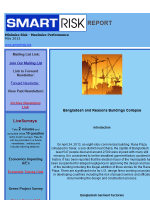 | Bangladesh and Reasons Buildings Collaspe (May 2013)
On April 24, 2013, an eight-story commercial building, Rana Plaza, collasped in Savar, a sub-district near Dhaka, the capital of Bangladesh. At least 547 people died and around 2,500 were injured with many still missing. It is considered to be the deadliest garment-factory accident in history. It has been reported that the elected mayor of the municipality has been suspended for alleged negligence in approving the design and layout of the building including the illegal addition of three stories for the Rana Plaza. There are significant risks for U.S. design firms working on projects in developing countries including the risk of project owners and officials circumventing the design and construction process. |
 | The Next Condo Wave and Risk (Apr 2013)
Apartments have been the leading project type, particularly in hot markets of Washington, D.C, New York, Chicago, Los Angeles, and Atlanta for the past three or four years. Industry experts expect 285,000 more units in 2013 and 320,000 in 2014. The rental-building boom is leading the way for the next wave of condominium projects. Planning and Zoning Commissions across the country are approving new projects including mixed-use, condos. Adding a risky twist to the most litigious project type, many under-construction apartment projects are expected to convert to for-sale condo units at a future date. |
 | Asia - Largest Growth Insurance Market (Apr 2013)
The Asia Pacific region will become the biggest driver of insurance premium growth in the world by 2020 according to a recent industry research study. Approximately $1.3 trillion in premium volume will be generated in the Asia Pacific region between 2013 and 2020; almost half of the premium generated worldwide. Insurance plays an important role in any risk management program. In these emerging insurance markets, it is essential that effective risk management strategies are identified and applied early in the development stages. |
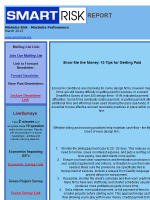 | Show Me The Money (Mar 2013)
Economic conditions are improving for some design firms, however many firms are still having difficulty in getting paid for services. In a recent SmartRisk Survey of over 200 design firms - 81% indicated payment difficulties. Some firms eventually obtain payment, or partial payment after additional time and effort has been used chasing the pass due funds. It is essential to have effective account receivable practices in place within your firm.
Effective billing and invoicing practices help maintain cash-flow - the life blood of every design firm.
|
 | Cyber Risk and U.S. Critical Infrastructure (Feb 2013)
Cyber threats are becoming more frequent with weekly headlines identifying breaches in computer systems. To obtain a sense a major cyber attack would have on the U.S. critical infrastructure, use the impact Superstorm Sandy had on the Northeast in late 2012 as an example. Water, power, gas, communications and transportation were out for weeks. It will take months, even years to recover from this event. The Federal Government estimates losses of that storm at approximately $45 billion but the governors of Connecticut, New Jersey and New York estimate losses at $82 billion. |
 | Bad A/E Contracts (Jan 2013)
There are two primary situations when an architect and engineers (A/E) contract is reviewed. First - when the parties are developing the terms and conditions for the project, and second - when there is a problem on the project and they want to determine who is liable. There are a number of reasons why design professionals end-up with bad contracts that cause problems for their firm and projects. However, no matter what the reason, these contracts can lead to disastrous results for design professionals. |
 | Statute of Limitations At Risk (Jan 2013)
Forty years after the Interstate 35 Bridge over the Mississippi river was built, it collapsed in 2007. Minnesota’s Supreme Court voided the 10-year limit on liability, allowing claims to be brought against the design and construction companies. More recently, the Connecticut Supreme Court rendered a decision holding the state immune from statute of limitations and repose defenses, and allowing the state to take action for construction and design defects on a law school library 12 years after completion. |
 | Visual Inspection Service Risk (Oct 2012)
Two months before the collapse of a Mall roof top, an engineering firm provided visual inspection services and photographs stating the shops were structurally sound. A suit was filed for $5 million. This accident clearly demonstrates the significant liability exposures design firms are exposed to when limited inspection or observation services are provided. |
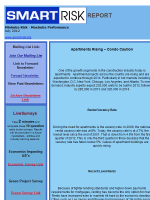 | Apartments Rising - Condo Caution (Jul 2012)
Apartments are on the rise but look around and you will see new condo projects being developed as well as apartments. Based on industry claims data including a recent SmartRisk Survey of A/E Law Firms (Law Firm Survey Report), condominium projects continue to be one of the most litigious project types. |
 | Conditions Improving For Some A/E's (Jul 2012)
There are some positive signs in the design and construction sectors. Surprising many in the industry, construction spending reached its highest level since December 2009. The Department of Commerce announced construction spending for May 2012 was at 0.9 percent above the April estimate of $822.5 billion. However, private construction spending increased while public spending decreased. Private construction was up 1.6 percent above the April estimate of $551.8 billion. Public construction spendin |
 | Options When A/E's Have Claims (Jun 2012)
When A/E firms have claims, it dramatically impacts their insurance options including carriers willing to offer terms, increase in premium and higher deductibles. This article addresses how an A/E insurance agent used SmartRisk's SR Risk Assessment for clients with claims to improve their insurance position.
|
 | Add Value, Reduce Risk & Increase Fees (May 2012)
It is essential design firms differentiate themselves from competition showing value, project knowledge, insights of challenges and risks, and quality in the services offered. This approach places your firm in a position for higher fees and also reduces risk. This article will identify key elements supporting this effort.
|
 | Getting Paid For Design Services (Apr 2012)
The last few years has been challenging for many design firms. Adding fuel to this fire is many firms are having difficulty obtaining payment for their services. In a recent and ongoing SmartRisk Survey - 81% indicated trouble with getting paid. Successful account receivable programs do not have to be time consuming or daunting. |
 | Financing & Restarting Stalled Projects (Mar 2012)
From coast to coast the American landscape is littered with thousands of stalled, partially built, financially distressed or bank owned properties. Stalled and abandoned projects have unique challenges and risks. A specific strategy must be developed outlining knowledge and management of those exposures. This strategy will assist in successfully restarting and completing a stalled project and aid in obtaining project financing. |
 | From The Experts: Criteria When Purchasing A/E Insurance (Feb 2012)
Reduced revenues resulted in fewer A/E firms today. However, at the same time, insurance carriers for this specialized segment has more than doubled to 50 - 60 providers, all competing for market share and a piece of a smaller premium pie. This creates advantages and disadvantages for A/E firms. To help sort through the important aspects when making this critical decision, leading insurance agents specializing in the A/E market segment in different regions of the U.S. were asked to provide their |
 | Insurance Update & A/E Insurance (Jan 2012)
The U.S. property and casualty (P&C) insurance industry combined loss ratio climbed to 109.9 in the first nine months of 2011 compared to 101.2 in 2010 (>100 indicates losses), the worst year since 2001.
The A/E industry has had significant reduction in revenue and size. However, there are now between 50 – 60 insurance carriers for this specialized segment. Firms are advised to look well beyond just premium costs when selecting an insurance provider.
|
 | Fed's Report: Growth, Construction Housing Flat (Jan 2012)
The Federal Reserve latest report on the nations regional economics showed positive signs of activity with the exception of the housing market. The report is a snapshot of business conditions in the 12 regional bank Districts for the Federal Reserve. Information is obtained by contacting industry leaders, economists, financial experts and businesses from retailers, hotels, manufacturers, travel, restaurants and building professionals. |
 | Risk Management for Asia Pacific Sustainable Projects (Jan 2012)
Sustainable or “Green” initiatives are gaining momentum around the world. SmartRisk was an invited speaker on the topic of sustainability and risk at the recent 2011 Asia Pacific Risk Management Conference that was held in Bali, Indonesia.
Significant interest is on sustainable strategies for the Asia and Pacific Region based on the increasingly resource-limitations and intensive growth due to rapid urbanization, increasing consumption and high economic growth. This growth has come |
 | |
 | Has the Economy Affected Your Firms Risk-Rating? (Aug 2011)
Economic conditions hit the world’s financial superpower with Standards & Poor’s historic decision to downgrade the U.S. credit rating. How has the economic climate impacted A/E firms risk-rating? Are firms making the right decisions today to manage risk effectively? Many firms have been forced to make changes based on reduced revenues and fewer projects opportunities. This article discusses economic risks and the use of risk assessments in identifying these exposures and methods... |
 | The Art of Designing in the Rain (Jul 2011)
It is more difficult to do anything in the rain. Racecar drivers do not like racing in the rain because the car is unpredictable on a wet track and amplifies when a driver makes a mistake causing spinouts and crashes. The driver in this article learned early from a veteran how to drive in these conditions and outperform other drivers. There are only two options: 1) Wait until something happens or 2) Create and control the outcome. This article talks about how A/E’s can take control and ... |
 | A/E Mergers and Acquisitions Increase 29% (Apr 2011)
Mergers and acquisitions (M&A) deals have
increased 29% compared to last years activity. There are many drivers for M&A deals and slow economic conditions, consolidation is a usual trend. Great care is needed when merging, selling or acquiring another firm. How a firm appears on paper and how they are in practice can vary greatly. If proper and complete due diligence is not performed, a firm can significantly decrease performance and significantly increase risk. |
 | When Selecting an Insurance Carrier (Apr 2011)
Based on an industry survey there are more carriers than ever before in the specialized A/E insurance segment. Insurance professionals stated there are now between 45 - 60 providers compared 17 five years ago. This is at a time when the A/E market is shrinking based on economic conditions with reducing annual revenues and an increase in merger and acquisition activity. Firms need to take great care and recommended to use a "quality" selection process when making this important business decision. |
 | Today, PM's Need More Than Technical Skills (Apr 2011)
Architect and engineers (A/E) firms are being asked to do more with less today. Sitting at the center of that picture is the Project Manager (PM). Being an effective PM today requires much more than just having technical skills and abilities. Especially in slow economic conditions, PM’s must effectively manage the financial viability of projects, they must also ensure the quality of service as well as being an effective communicator. Ten important PM responsibilities to be effective. |
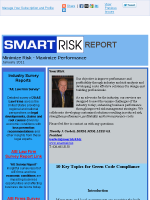 | 10 Key Topics for Green Code Compliance (Jan 2011)
There are numerous state, city, county programs and requirements related to sustainable buildings. Some have mandatory requirements with voluntary provisions. This articles highlights 10 key topics regarding green buildings and code compliance. Based on the state-wide program implemented in California, CalGreen will is used as a primary example of compliance issues, concerns and recommendations. |
 | Strictest Green Building Code in the U.S. (Jan 2011)
Effective January 1, 2011, possibly the most stringent environmental building code in the United States is now being enforced applying to new construction. The new code for the state of California is called CalGreen requiring reduced indoor water use, diverting 50 percent of construction waste from landfills to recycling, use of low-pollutant materials, and installation of separate water meters for different uses in nonresidential buildings. This article summaries the requirements of the new Cal |
 | LEED Lawsuit Amended (Feb 2011)
The $100 million dollar lawsuit filed in October 2010 against the U.S. Green Building Council (USGBC) and it’s LEED rating system has been amended. Filed February 7th, 2011, the amended lawsuit focuses on USGBC’s alleged false advertising that LEED guarantees energy savings. The lawsuit is also no longer a class-action lawsuit and the plaintiffs are four design and construction professionals on behalf of other industry professionals. |
 | Top 10 Risk Mitigating Practices for 2011 (Jan 2011)
As we move into 2011 there are practices firms should focus on for improved performance and reduced risk. During slow economic conditions, parties are more willing to litigate, file claims sooner and for smaller amounts.There are firms in a better prepared position today along with primed pumps when economic conditions improve. What are these firms doing differently? They have implemented effective strategies for mitigating risk as well as improving performance. |
 | LEED Lawsuits (Nov 2010)
Alleged false advertising, monopoly tactics and LEED buildings actually performing 29% less energy efficient than conventionally-built structures, a $100 million lawsuit was filed against the U.S. Green Building Council (USGBC) and it’s Leadership in Environmental and Engineering Design (LEED) rating system. This newsletter addresses this lawsuit along with other industry green lawsuits, sustainable growth projections and risk management considerations.
|
 | Reduce Risk, Improve Performance & Insurance Costs (Oct 2010)
In this challenging economic climate, A/E firms have been forced to become more efficient and resourceful while reducing overhead and operating costs. Firms must be aware that efforts may inadvertently have the opposite effect. Changes are negatively affecting performance resulting in increased risk and liability exposure.
Firms should seek assistance when making these decisions. SR Risk Assessments have proven to be very for; mitigating risk, improving performance and reducing insurance costs. |
 | Indemnity Victory for Design Professionals (Oct 2010)
On September 29, 2010, California Governor Arnold Schwarzenegger signed legislation, SB 972 changing the indemnity ruling for design professionals that takes effect January 1, 2011. The new law states that contracts between design professionals and local public agencies that defense costs and indemnity must be based on negligence, recklessness or willful misconduct of the design professionals. Based on recent court decisions, this is a great victory for all DP's. |
 | Economics Increasing A/E's Risk (Jul 2010)
The economic climate has dramatically changed the landscape for many A/E firms. 92% of all design firms have been negatively impacted by the economic downturn. Firms have been forced to reduce overhead and implement cost-cutting measures including reduction in staff, reduced workweeks, changes in business practices, operations, explore new markets and service segments in an effort to stay afloat and increase revenue. All realities in today’s economic, however in many cases is altering and |
 | Sustainable Design & Risk (Mar 2010)
The interest along with the requirements for sustainable design and construction concepts is growing daily. With this opportunity comes increased risk and liability for design professionals. Sustainable design incorporates concepts using innovative products, energy efficient materials and construction methods. For buildings, certification programs promote improved health and well-being of occupants and students. Since there is no proven track record for many of these sustainable concepts, it pre |
 | Characteristics of Higher Performing A/E Firms (Apr 2010)
The last few years have been very challenging for many A/E firms with little relief in sight. Even more troubling is firms not implementing change and adapting to market conditions could find themselves in the middle of a slow, painful death. There are firms succeeding today in addition to putting themselves into a better-prepared position when economic conditions improve. What are these firms doing differently? This newsltter addresses those issues. |
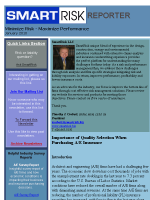 | Importance of Quality Selection When Purchasing A/E Insurance (Jan 2010)
There are more A/E PL insurance providers than ever before, with wide variations in capabilities and services....all competing for A/E premium dollars. Firms should evaluate the "quality" aspects of insurance providers the same way they ask clients to select project consultants and contractors. This decision should be based on quality, not a low-bid process. This newsletter identifies the quality aspects firms should consider when purchasing PL insurance. |
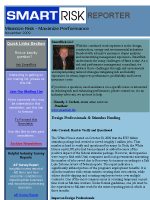 | Is Stimulus Funding Helping A/E Firms? (Nov 2009)
Unemployment rate for A/E's has doubled in the last year with 113,00 looking for work. Shovel ready stimlus projects have provided little help for many firms. However, there are opportunities but you must be knowledgable of the process and have an effective strategy for obtaining federal contracts. Information is provided on doing your homework, where to look for federal work along with steps in helping you through the process. |
 | Low Construction Bids Increasing Risk for A/E Firms (Sep 2009)
Constructions Bids & Risk. Constuctions bids on coming in well below engineering and agency estimates, increasing risk for design professionals. It is important to Identify these risks and implement effective risk management strategies mitigating risk, improving performance, profitability and protecting your firms financial viability and future. |
 | Slow Economic Conditions and Risk (Sep 2009)
Economic conditions are causing firms to change they way they do business. Trying to survive, firms are going into new services areas, project types, clients and regions. Minimizing operating costs, firms have had layoffs, trimmed operational budgets impacting insurance purchasing decisions. All items increasing risk. As firms make changes, they need to realize the risks and incorporate effective risk management strategies moving forward. |
 | A/E Firms Accepting More Risk Driven By Economic Conditions (Aug 2009)
Based on a survey of 17 A/E PL Carriers, A/E firms are accepting more risk, offering new services outside their noral area of expertise, working with clients and projects they would not accept under normal circumstances, not purchasing insurance, lowering limits, increasing deductibles, etc. In this difficult economy, it is a natural reaction to identify methods to cut operating costs. However, firms should not be short-sighted when making these decisions. During a slow economy, claims and litig |
|
|
|































































































